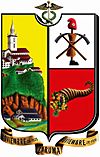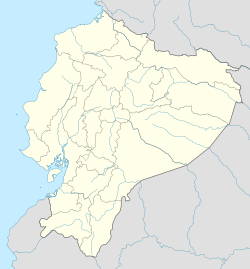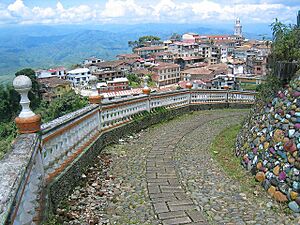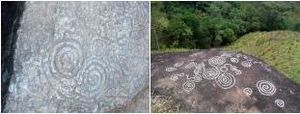Zaruma facts for kids
Quick facts for kids
Zaruma
|
|||
|---|---|---|---|
|
Town
|
|||
| Villa Real De San Antonio del Cerro de Oro de Zaruma | |||
|
|||
| Nickname(s):
Sultana de El Oro
|
|||
| Country | Ecuador | ||
| Province | El Oro Province | ||
| Canton | Zaruma Canton | ||
| Foundation | December 8, 1595 | ||
| Founded by | Damian Meneses | ||
| Named for | zara and huma | ||
| Government | |||
| • Type | Mayor and council | ||
| Area | |||
| • Town | 2.6 km2 (1.0 sq mi) | ||
| Elevation | 1,200 m (3,900 ft) | ||
| Population
(2022 census)
|
|||
| • Town | 10,005 | ||
| • Density | 3,850/km2 (9,970/sq mi) | ||
| Demonym(s) | Zarumeño(-a) | ||
| Time zone | UTC-5 (ECT) | ||
| Postal code |
EC071150 (new format)
|
||
| Area code(s) | (0)72972, (0)72973 | ||
| Website | http://www.zaruma.gob.ec | ||
Zaruma, officially known as Villa Real de San Antonio del Cerro de Oro de Zaruma, is a historic town in southern Ecuador. It is located in the El Oro Province, high up at 1200 metres above sea level. This town sits where two mountain ranges, Vizcaya and Chilla, meet. Zaruma is also the main town of Zaruma Canton, one of the oldest areas in the province.
Zaruma is famous for its old buildings from the time of the republic. It is also known for its gold mines, rich culture, and delicious coffee. The Spanish explorer Alonso de Mercadillo founded this town. Because of its special qualities, Zaruma has received many awards. In 1998, it was even suggested as a UNESCO World Heritage Site.
In 2019, the Ecuadorian Ministry of Tourism named Zaruma a Pueblo Mágico, or "magical town." It was one of the first five towns to get this special title.
What Does Zaruma Mean?
The name Zaruma comes from two Quichua words. Sara means "corn," and uma means "head." So, Zaruma can be translated as "corn head." This name might refer to the corn grown there. It could also refer to the gold mined in the area, which looks like a corncob. No one knows for sure why the spelling changed from "Saruma" to "Zaruma." However, historian Jorge Núñez believes Zaruma means "small mountain peak."
A Look at Zaruma's Past
Early People and Tribes
Long ago, one of the first groups of people in this area was called Zarzas. This group included eleven different tribes. Among them were the Cariamangas, Catacochas, and the Zarumas.
The Cañari People Arrive
Experts believe the Cañari people settled in what is now Zaruma canton. This happened between the years 500 and 1400 CE. We know this because many old archaeological sites have been found. Places like Guayquichuma and Chepel show signs of the Cañari people.
The Inca Empire Takes Over
Around the 1480s, the Incas arrived in Zaruma. They were led by Huayna Capac. After exploring the north, the Incas took control of the Zaruma area. They ruled the local Cañari people for about 50 years.
The Incas in Zaruma later tried to help free their leader, Atahualpa. He was captured by the Spanish. In 1533, their chief, Quinará, gathered a lot of gold for Atahualpa's ransom. But when he learned Atahualpa had been executed, he buried the gold. This treasure was hidden in deep tunnels near the Guatuchi Hacienda.
Spanish Arrival and Town Founding
In 1549, the first Spanish settlements began in this region. They were started by the Spanish leader Alonso de Mercadillo. Zaruma became very important because it had rich gold deposits. Because of this gold, Philip II of Spain gave it a special title. On October 17, 1593, it was named "Villa de Sant Antonio del Zerro de Oro de Zaruma."
On December 8, 1595, Captain Damián Meneses officially founded Zaruma. He was following orders from García Hurtado de Mendoza, the Viceroy of Peru. This founding changed the area greatly. It led to the loss of local cultures as a new dominant culture was introduced.
In 1749, an earthquake destroyed much of the city and its mines. After this, Zaruma faced tough times. But with hard work from miners and help from the Spanish Crown, things improved. New workers were brought in for the mines. It is thought that between 1536 and 1820, Spain gained about 2,700 tonnes of gold from Zaruma.
Gaining Independence
On November 26, 1820, Zaruma declared its independence from Spain. People in Zaruma, inspired by other cities, decided to be free. They did this even though the government of Loja was against it. Important citizens like Fray Justo Gaona and Francisco Barnuevo signed the independence document. This document is now seen as their act of freedom.
After gaining independence, the area faced a period of economic difficulty. However, its gold mining industry never completely stopped.
Zaruma's Gold in Gran Colombia
On June 25, 1824, Zaruma became a canton. This was part of a new law for how Colombia was divided. Zaruma was placed in the province of Loja. Simón Bolivar, a famous leader, wanted to boost mining. He passed new mining laws in 1829. He also appointed Sr Manuel Astudillo Samaniego to manage mining in Zaruma.
Restarting the Economy
The new government invited experts and businesses from around the world. They wanted people to invest in mining, especially in Zaruma. In 1862, García Moreno created a tax on mining to help Zaruma. Later, in 1876, a German geologist named Teodoro Wolf studied Zaruma's mines. In 1860, a large company called the Great Zaruma Gold Mining Company Limited was formed. It had a lot of money from English investors.
El Oro Province is Formed
On November 29, 1882, Zaruma, Machala, and Santa Rosa decided to create a new province. They named it El Oro, meaning "The Gold," because of the region's rich gold. Zaruma was the capital of this new province until 1884. On April 23, 1884, a new law recognized the province. However, the capital was moved to Machala.
Other Important Dates
In 1990, the Ecuadorian Ministry for Education and Culture declared Zaruma a Cultural Heritage site. This means it is a special place with important history and culture. Since 1998, Zaruma has been considered for a World Heritage Site by Unesco. In 2022, scientists found a new type of tarantula in Zaruma. They named it Pamphobeteus zaruma after the town.
Zaruma's Weather
| Climate data for Zamura, elevation 1,150 m (3,770 ft), (1971–2000) | |||||||||||||
|---|---|---|---|---|---|---|---|---|---|---|---|---|---|
| Month | Jan | Feb | Mar | Apr | May | Jun | Jul | Aug | Sep | Oct | Nov | Dec | Year |
| Mean daily maximum °C (°F) | 27.3 (81.1) |
26.3 (79.3) |
26.7 (80.1) |
27.1 (80.8) |
27.7 (81.9) |
27.3 (81.1) |
28.1 (82.6) |
28.9 (84.0) |
29.2 (84.6) |
28.6 (83.5) |
29.2 (84.6) |
28.2 (82.8) |
27.9 (82.2) |
| Mean daily minimum °C (°F) | 16.7 (62.1) |
16.6 (61.9) |
17.1 (62.8) |
17.2 (63.0) |
16.8 (62.2) |
16.5 (61.7) |
16.3 (61.3) |
16.1 (61.0) |
16.2 (61.2) |
16.5 (61.7) |
16.3 (61.3) |
16.5 (61.7) |
16.6 (61.8) |
| Average precipitation mm (inches) | 199.0 (7.83) |
236.0 (9.29) |
297.0 (11.69) |
221.0 (8.70) |
100.0 (3.94) |
23.0 (0.91) |
5.0 (0.20) |
7.0 (0.28) |
22.0 (0.87) |
33.0 (1.30) |
29.0 (1.14) |
101.0 (3.98) |
1,273 (50.13) |
| Average relative humidity (%) | 84 | 86 | 86 | 85 | 84 | 85 | 82 | 80 | 79 | 80 | 78 | 80 | 82 |
| Source: FAO | |||||||||||||
See also
 In Spanish: Zaruma para niños
In Spanish: Zaruma para niños






